2.5 - Zonation, Succession, and change in ecosystems (ESS)
1/76
There's no tags or description
Looks like no tags are added yet.
Name | Mastery | Learn | Test | Matching | Spaced |
|---|
No study sessions yet.
77 Terms
Biome
A collection of ecosystems sharing a similar climatic condition
Succession
The process of change over time in an ecosystem involving pioneer, intermediate, and climax communities.
Zonation
Changes in a community along an environmental gradient due to factors such as changes in altitude, latitude, tidal level or distance from the shore (coverage by water). It can occur at a variety of scales from global (biomes) to very local (moving from the edge of a lake).
Insolation
The amount of solar radiation reaching a given area
Precipitation
Rain, snow, sleet, or hail - water that moves from a gaseous state, condenses and falls to the ground.
Tricellular model
The model which describes 3 large convection cells moving air from the equator towards the poles in each hemisphere of the earth that explains the distribution of precipitation and temperature that influence structure and relative productivity of different terrestrial biomes.
Terrestrial
relating to the earth i.e. ecosystems occurring on land.
aquatic
relating to water i.e. ecosystems dominated by water.
R-strategist
species that produce large numbers of offspring so they can colonize new habitats quickly and make use of short-lived resources.
k-strategist
species that tend to produce a small number of offspring, which increases their survival rate and enables them to survive in long-term climax communities.
Climax community
There is no one climax community but rather a set of alternative stable states for a given ecosystem. These depend on the climatic factors, the properties of the local soil and a range of random events that can occur over time. Historically it is thought of as the community of organisms at the end point of succession but succession never really ends.
Community respiration
The total respiration rate for all the populations within that system.
Productivity: Respiration ratio
The ratio between how productive a system is and how much respiration is happening. As a system approaches its climax community, gross productivity = respiration rates and so P:N approaches 1.
Nutrient and energy pathways
The ways that nutrients/minerals and energy move through an ecosystem. These tend to become more complex as a system undergoes succession. Often represented by a food web.
Alternative stable state
A stable state that is the result of a series of feedback loops and random events which give rise to a particular set of biotic and abiotic conditions. A particular system may be able to exist under several alternative stable states but will be the result of the random events and feedback.
Stochastic
Having a random probability distribution.
Climate
the average of the weather over a relatively longer period of time, usually about 30 years of data is required to give the climate of an area.
Weather
the conditions is a given place at any one time. It is measured by the temperature, air pressure, precipitation (rain/snow etc.), wind speed, humidity.
Environmental gradient
Changes in abiotic factors across a rising altitude of an area.
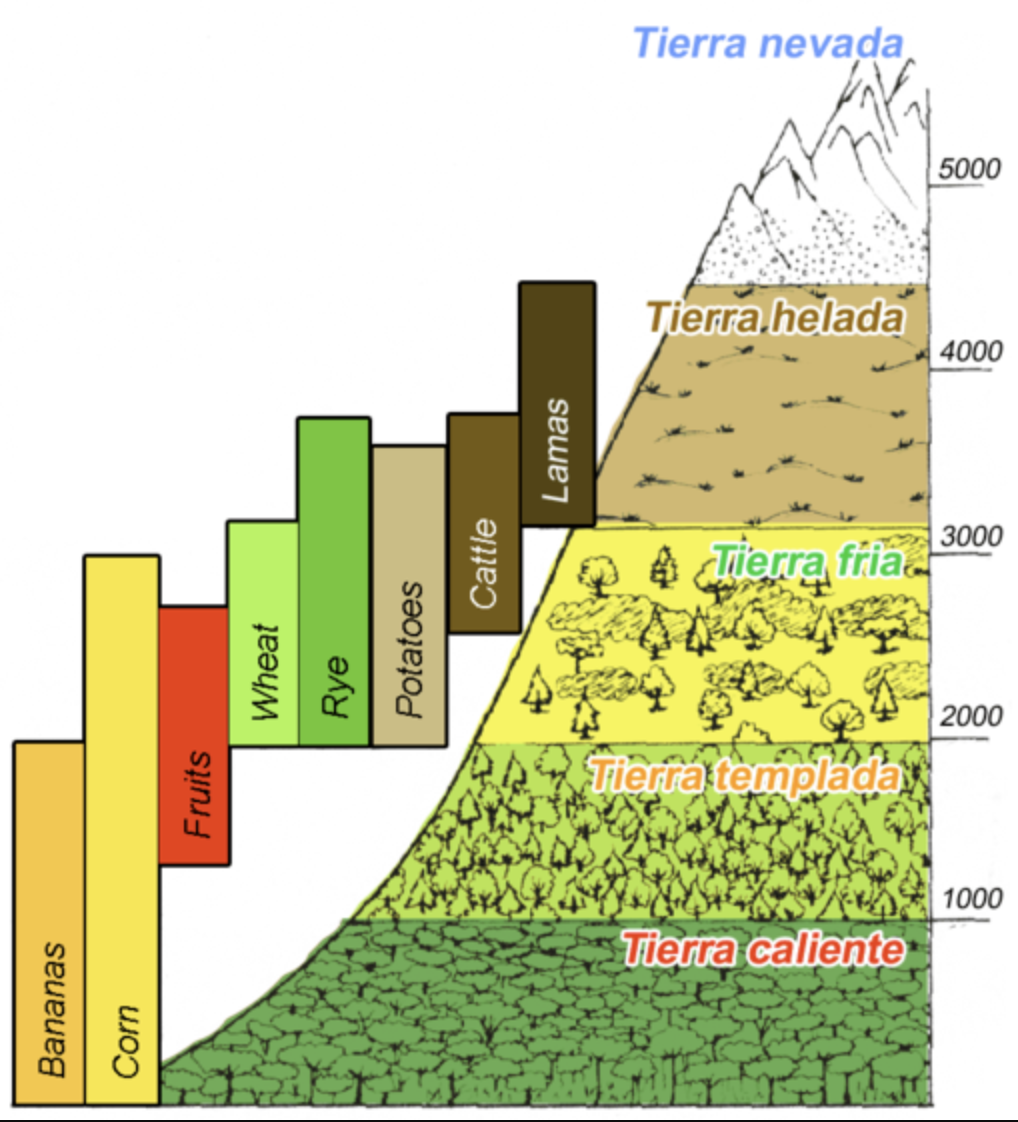
Elevation (Montane Zonation) - factor that allows zonation
The image shows the altitudinal zones of the Andes Mountains and the corresponding communities of agriculture and livestock. Temperature and oxygen availability are the major abiotic factors determining the zones but ultraviolet radiation may also be a factor at high altitudes.
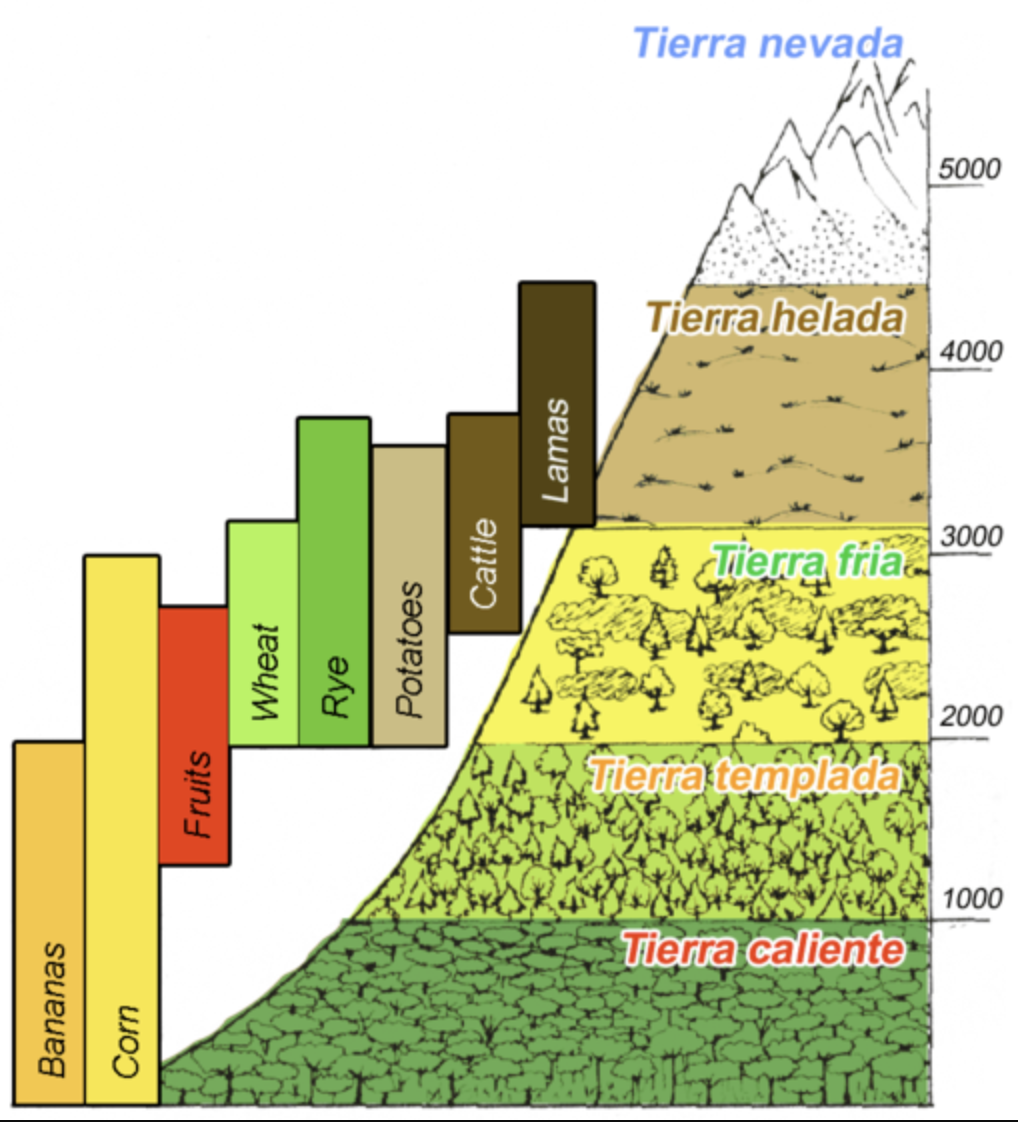
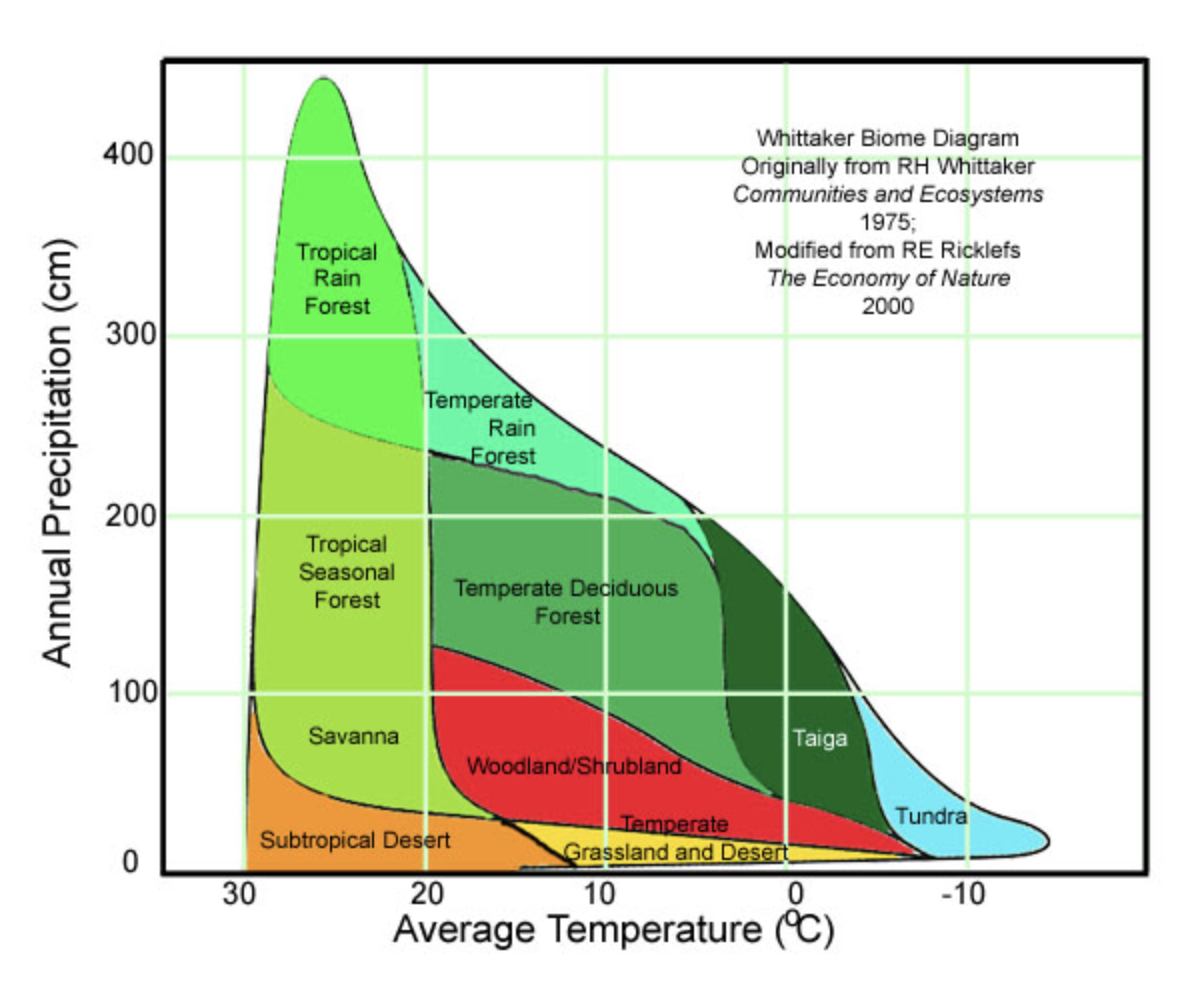
Latitude (biomass) - factor that allows zonation
Biomes are examples of the effects of changing latitude which impacts the amount of insolation, temperature, and precipitation. They are examples of zonation on a global scale.
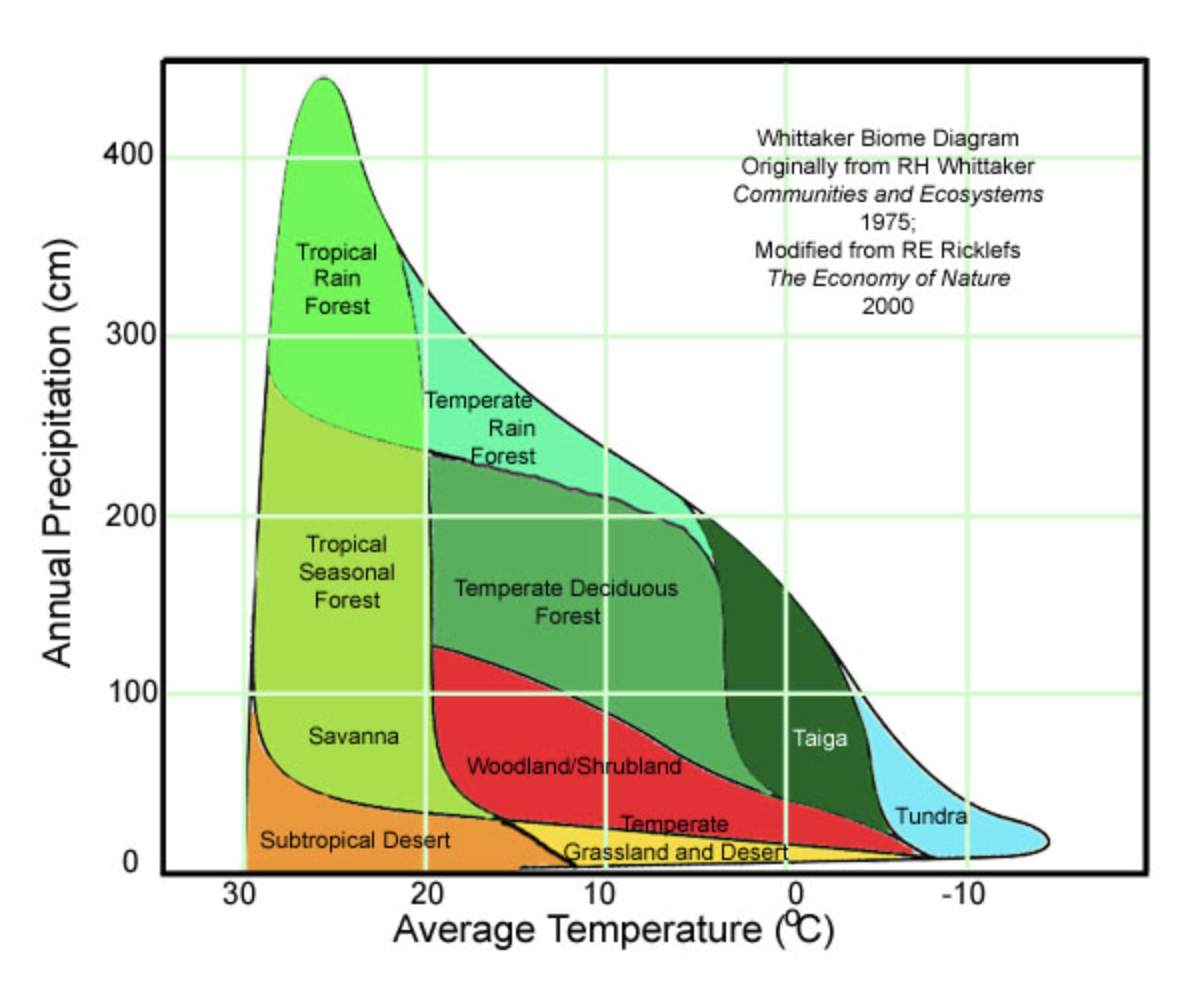
Tidal level
As you progress from the sea to land in tidal areas, there are different zones, each with a different set of organisms adapted to the specific conditions found there. Important abiotic factors that determine intertidal zones are wave action, salinity, temperature, and submersion (time of exposure to open air). Intertidal zone - change in the environmental conditions from the high tide to low tide coverage and exposure. Organisms in these zones must be able to survive these constant changes and have found a number of adaptations to doing so. To prevent desiccation (removal of moisture) during low tide, animals have shells within which they can withdraw like snails, limpets, mussels, and hermit crabs, or they have thick skins like sea stars, and giant sea anemones.
Sea anemones
Some anemones stick light colored sediment to their tentacles then withdraw inside their bodies to prevent dry out.
Sea stars
Some sea stars emit a thick mucus coating on their outer surface to prevent dry out.
Preventing from being knocked around by high waves and currents
Gastropods, like abalone and limpets, have strong feet that stick to rocks. Barnacles attach their shells directly to the rock. Sea urchins and boring clams carve out holes within which they can nestle. Sea stars, sea urchins, and sea cucumbers have tube feet that stick strongly to rocks thanks to their water vascular system which creates high amounts of suction. Mussels attach strong byssal threads to the rocks. Kelp attach themselves with holdfasts.
Handling the large range of predators that arrive during high tide and low tide
Anemone and corals have stinging cells on their tentacles, nudibranchs eat anemones and use those same stinging cells for deterring their own predators. Sea stars can regenerate lost limbs, octopus can camouflage themselves to match their surroundings and use ink to distract predators, and sea stars and mussels and others can clamp so tightly to the rock they are nearly impossible to pull off.
Finding a mate
Sessile (permanently stuck) benthic intertidal organisms will release egg and sperm into the water column at the same time, like corals do, in the hopes that they will get together in the planktonic world. Abalone and sea urchins do the same. Many organisms, like anemones, have a second method of reproduction - cloning - which they use most of the year to expand their populations. These grow buds which then migrate off their own bodies, take up residence next door, and grow into a cloned version of the parent.
Handling rapid changes in salinity, pH, and oxygen levels that occur during low tide
Organisms have shells in which they can retreat, such as barnacles or crabs. Most have adapted metabolisms that can handle these wide ranges, and many can lie dormant and even mostly desiccated, with no damage, up to 12h.
Handling the lack of abundant attachment sites
Organisms have learned to live atop each other. Bryozoans cover the surfaces of kelp blades. Corals grow cloned colonies atop each other in branching and other ornate shapes. Mussel shells act as surfaces on which barnacles, bryozoans, tunicates, sponges, and sea lettuce can grow.
The rocky intertidal shorelines typically show vertical zonation
which means that organisms are uniquely adapted to survive in one of the many zones will thrive in those zones and be found only there. They will likely competitively exclude other species from those zones.
Competitive exclusion
a process where a favored species can outcompete other species for resources, reducing diversity of a community.
SPRAY ZONE
Organisms that are the most competitive are those that can survive under high amounts of salt and occasional submerging - periwinkle snails, and limpets.
HIGH TIDE ZONE
Will be covered only a few hours a day. Organisms in this zone = periwinkle snails, limpets, buckshot barnacles.
MIDDLE TIDE ZONE
Always alternately covered and uncovered each day. Organisms here must be able to handle the most consistent alternation of wet and dry.
LOW TIDE ZONE
Uncovered only during the lowest low tides - completely uncovered during low spring tides and never uncovered during low Neap tides. Competitive organisms will handle being submerged and very limited times being exposed.
Soil horizons
Each layer has varying proportions of organic and inorganic material, organisms, air and water. The combination of layers is known as a "soil profile" and varies with many factors including human impact and climate.
Distance from a water source
As you progress into a lake from the areas surrounding the lake there will be changes in soil humidity, oxygen availability (for the roots) and as you enter the lake, light availability and temperature. The diagram shows a typical zonation pattern of this nature (along with elevation)for Lakes Manapouri and Te Anau in New Zealand.
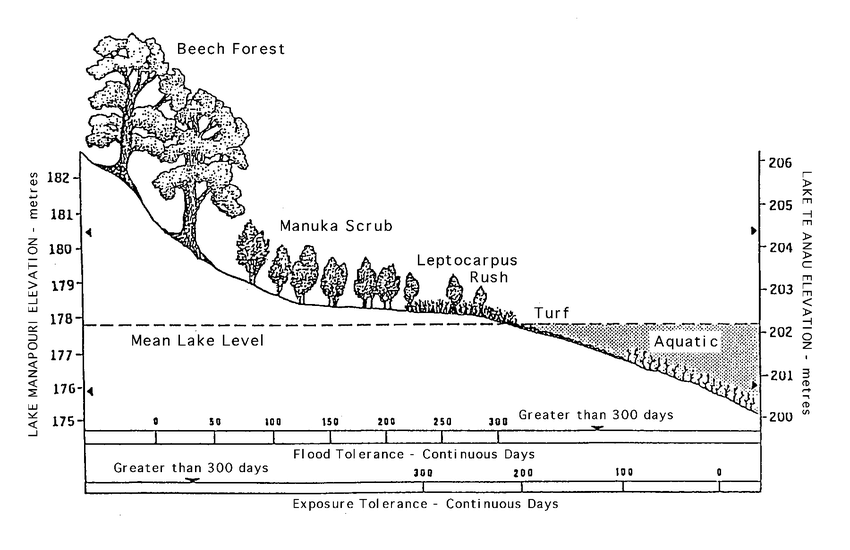
Transects
can be used to measure biotic and abiotic factors along an environmental gradient in order to determine the variables that affect the distribution of species. This simplest type of transect involves a tape measure and a quadrat. Random sampling would not be appropriate here as the environmental variables are changing along a gradient so the use of a line transect would allow the sampling to be done systematically.
Kite diagrams
used to display the number of animals or percentage cover for plants across a transect. The distribution of organisms in a habitat is influenced by the presence of other living organisms, such as herbivores or predators that might eat them, as well as abiotic factors like availability of light or water. The width of the kite in the diagram represents the number of species in the habitat. They are most commonly used to illustrate the zonation along a transect.
Peat moss - pollen records
thrives in constantly wet environments and slowly accumulates over time, forming thick layers of peat. These layers act like a natural archive, trapping pollen grains from the surrounding vegetation. By analysing the different types and quantities of pollen preserved in these layers, scientists can reconstruct past vegetation communities. In the Southern Vosges Mountains, Northeastern France, the Grande Pile peat bog gives a continuous pollen sequence for the last 140,000 years.
Pollen Signature of different stages.
Different plant species produce pollen with distinct characteristics. Analyzing the dominant pollen types in each peat layer reveals the major plant communities that existed when that layer formed.
Change Over Time
As we move deeper into the peat layers, representing older times, the pollen composition typically changes. This reflects the shifts in vegetation over time, a hallmark of ecological succession.
Succession Sequence
By following the changes in pollen dominance through the peat profile, scientists can infer the sequence of plant communities that replaced each other over time. For example, a shift from pioneer species like grasses and herbs to pollen indicative of shrubs and then trees might represent the progression from bare ground to a forest ecosystem.
Primary succession
sequence of succession starts on bare, uncolonized ground which has never had any vegetation growing on it before or in newly formed lakes. Most bare areas today are exposed because existing vegetation has been destroyed by fire or covered with flood silt or volcanic ash. Bare areas are rare but they occur on sand dunes, the lava flows of volcanoes, new volcanic islands, landslips and the glacial debris by melting glacier ices. The remains of glacier tills left by retreating ice sheets and lakes formed in hollows and blocked glacial valleys were very common at the end of the last ice age.
Secondary succession
he vegetation re-colonising the area will be affected by conditions not available in primary succession. This includes the remnants of soil, organic matter, seeds and even some plants which have survived the changes. This sequence of changes on disturbed land is called secondary succession.
A typical lithosphere sequence of succession
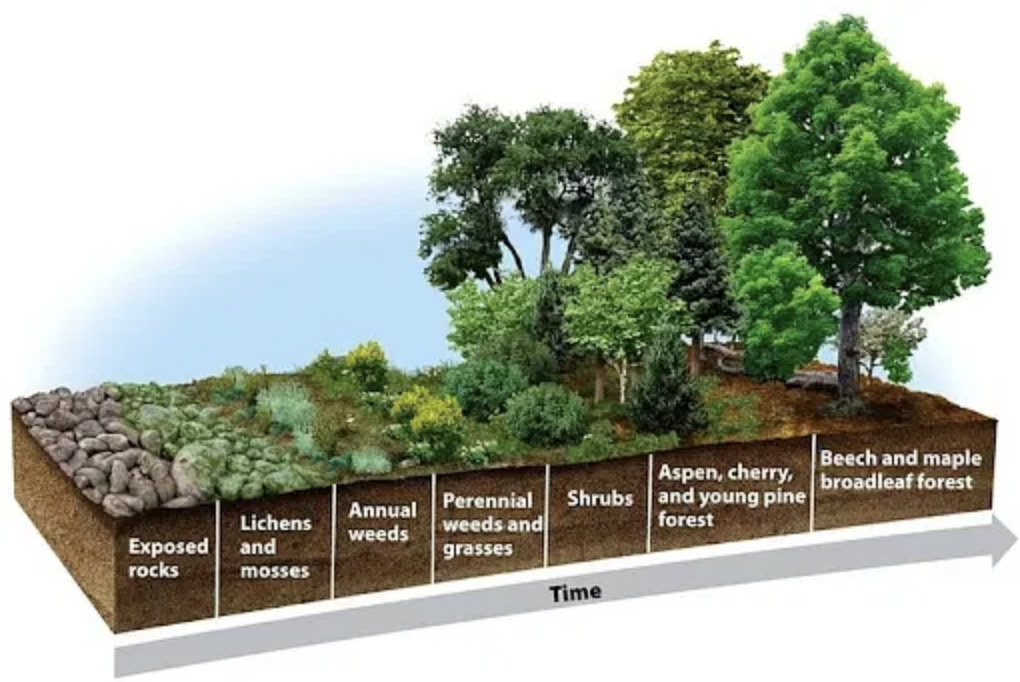
Sequence of vegetation types which occur in primary succession - sere
Xero-sere = Ecological succession that occurs in dry environments. Examples: Deserts, Sand dunes, Rocky areas.
Hydro-sere = Ecological succession that occurs in wet environments. Examples: Lakes, Ponds, Wetlands.
Litho-sere = Ecological succession that occurs on barren rock surfaces. Examples: Lava Flows, Glaciated areas, Landslides.
Primary Succession occurred on vast expanses of land after the retreat of the last ice age c. 13000 years ago.
The study of the early phases of such succession comes from direct observation of recently exposed sites and by investigating fossil pollen records from regions exposed at the end of the last glacier period.
Start of succession
Starts when autotrophs begin to live in the area. The structure and nutrient content of exposed ground will affect which species become the first colonizers. Bare rocky areas are often invaded first by animals like spiders which can hide in the cracks between boulders. Such animals are carnivorous or scavengers and live by feeding on insects which have been blown in by mistake.
Pioneer Stage (e.g. Bare ground)
Energy flow: Simple, low efficiency
Gross productivity: Low
Net Productivity: relatively high
Species diversity: Low (Lichens, Mosses)
Soil depth: Shallow
Mineral Cycling: Limited
Early Succession Stage (e.g. Grasses, Herbs)
Energy flow: Increased efficiency
Gross productivity: high
Net productivity: high
Species diversity: Low to Moderate (Grasses, Wildflowers)
Soil depth: Increased Depth
Mineral Cycling: Moderately Increased
Mid Succession Stage (e.g. Shrubs)
Energy flow: More complex
Gross productivity: High
Net productivity: High
Species diversity: Moderate (Shrubs, Early Trees)
Soil depth: Increased depth with organic matter accumulation
Mineral cycling: Increased cycling
Late Successional Stage - Climax (e.g. Mature Forest)
Energy flow: Most complex and efficient
Gross Productivity: high
Net productivity: low
Species diversity: High (trees, understory plants, fungi)
Soil depth: Deepest with rich organic layer
Mineral Cycling: Most efficient cycling
Stability of a System
An ecosystem’s capacity to survive change may depend on its diversity and resilience. A newly formed pioneer community will have very simple communities with short food chains and limited resilience to change. A more mature climax community may have more complex communities and therefore greater resilience. Ancient climax communities in environments which are harsh may have simpler communities and lower resilience.
basic causal loop diagram to depict the interplay of the key concepts of stability, diversity, succession and human impact
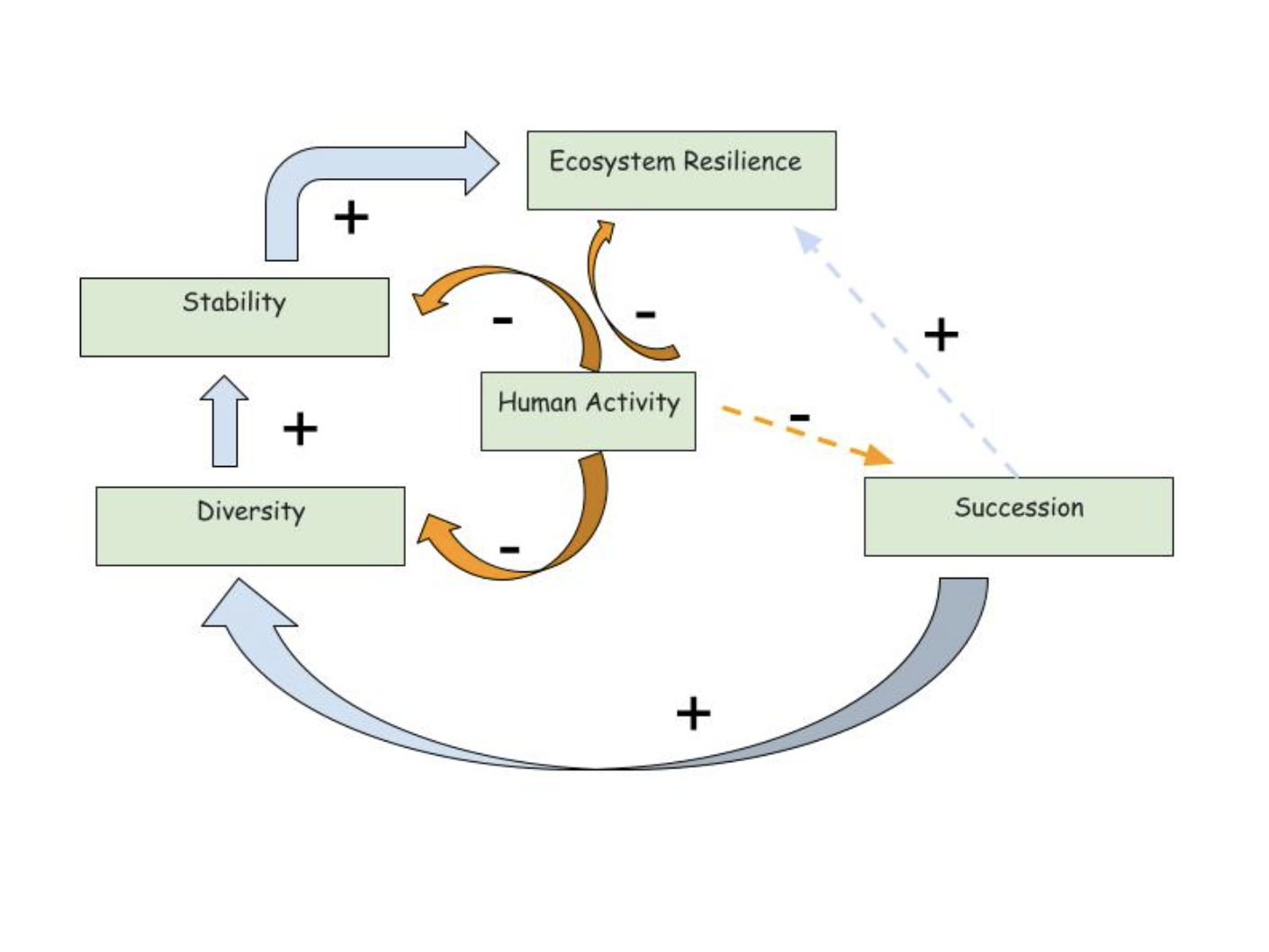
Surtsey Island - a volcanic island near Iceland that emerged from the ocean in 1963. Since then, it's become a hotspot for studying primary succession.
Initial colonization by pioneer species:Lichens and mosses arrive via wind dispersal and bird droppings, establishing themselves on the barren volcanic rock. These pioneering species are adapted to withstand harsh conditions like high winds, salt spray, and minimal nutrients.
Primary successional processes:Lichen and moss decomposition: As lichens and mosses die, they decompose over time, contributing organic matter to the new substrate. This initial layer of organic matter helps trap windblown particles, aiding in the formation of rudimentary soil. Nitrogen fixation: Certain pioneer mosses have a symbiotic relationship with nitrogen-fixing bacteria. These bacteria convert atmospheric nitrogen into a usable form, enriching the developing soil.
Establishment of vascular plants:With the formation of a thin layer of soil and some trapped nutrients, seeds of grasses, herbs, and other vascular plants arrive by wind and bird dispersal. These plants can establish themselves due to the slightly more favourable conditions.
Increased organic matter: The vascular plants contribute significantly more organic matter to the soil as they die and decompose, further enriching the soil and enabling the establishment of more complex plant communities.
Development of shrubland: As the soil matures and conditions become more favourable, hardier shrubs like sea campion (Silene uniflora) can take root. The presence of these shrubs alters the microclimate, creating more sheltered areas suitable for other plant species.
Succession towards a more complex climax ecosystem: The arrival of insects, birds, and even seals introduces new dispersers for seeds and propagates further colonisation. These animals also contribute to nutrient cycling and soil development. Over time, this progressive development paves the way for a more diverse and complex ecosystem to establish itself on Surtsey.
Mapping databases to recreate or map the changes through succession in a given area.
Mapping software in the form of ArcGIS or Google Earth can be used to map succession in a given area through time. Google Earth has an easy-to-use time-lapse function which allows you to watch planetary change over 4 decades.
Nepal’s Forests: From Decline to Remarkable Recovery
Nepal's hillsides faced a major ecological threat in the 1970s. Overgrazing by animals and excessive cutting of firewood for fuel were causing significant damage to the forests. This deforestation led to increased flooding and landslides, raising serious concerns. A World Bank report in 1979 warned that without large-scale efforts to restore the forests, they could vanish entirely by 1990. Fortunately, the 1980s and 1990s saw a shift in Nepal's approach to forest management. The government implemented a landmark forestry act in 1993. This law empowered local communities to take control of national forests through the creation of community forest groups. Recent research funded by NASA revealed a remarkable outcome: Nepal's forest cover nearly doubled. Satellite data from Landsat missions, combined with interviews conducted in Nepali villages, provided strong evidence that community-based forest management was key to this impressive regrowth. This increase in forest cover was most evident in the middle elevations, specifically the hills between the Himalayas and the Ganges plains.
Jefferson Fox, the lead researcher on the NASA Land Cover Land Use Change project
"When communities became actively involved in managing the forests, natural regeneration became the primary driver of forest regrowth." Before the 1993 act, government forest management was less proactive. "People still relied on the forests, but they weren't allowed to participate in managing them, and there wasn't any reason for them to invest their efforts in protecting them." This resulted in overgrazing and excessive firewood collection, leading to forest degradation. While community members could still gather resources like fruits, medicinal plants, and animal fodder from the forests, they often implemented restrictions on grazing, tree cutting, and firewood collection. Additionally, community members actively patrolled the forests to ensure their protection.
Climatic factor influencing succession
Temperature, precipitation, and sunlight availability all affect which species can survive and thrive in an area. For example, colder climates may favour coniferous trees over broadleaf trees in succession.
the properties of the local bedrock from which different types of soil can develop
the properties of the local bedrock from which differe
Fire and weather related events
Top-down influences from primary consumers or higher trophic levels (e.g. Wolves in Yellowstone or elephants in savannah)
Predation by herbivores (primary consumers) or browsing by larger animals can influence the composition of vegetation. For instance, wolves in Yellowstone National Park help control elk populations, allowing a wider variety of plants to thrive, and affecting the course of succession.
Energy and Matter Cycling in a Successional System
In early stages of succession, gross productivity (GP) is low due to the unfavourable initial conditions and the low density of producers. The proportion of energy lost through community respiration is relatively low too, so net productivity is high, that is, the system is growing and biomass is accumulating.
In later stages of succession, with an increased consumer community, gross productivity may be high in a climax community.
However, this is balanced by respiration, so net productivity approaches 0 and the productivity–respiration (P:R) ratio approaches 1.
In a complex ecosystem, the variety of nutrient and energy pathways contributes to its stability. This is the way that energy and minerals/nutrients cycle through a food web. The more complex the feeding relationships, the more stable the ecosystem.
R-strategists (Inthinking)
r-strategists usually lay many eggs / have many offspring, give little care to the offspring and a large proportion of the offspring die before reaching maturity, such as this frog and it's frog spawn
K-strategist (Inthinking)
K-strategists tend to give more parental care to the offspring, investing more energy into the process, therefore being more competitive in stable, established environments such as this Iberian Lynx.
Climax Communities and Alternative Stable States
Succession generally ends with a community whose populations remain stable until disrupted by disturbance. Analysis of lake core samples and peat bogs which record the vegetation history of an area have been useful in studying the factors affecting the climax communities. At each stage in succession, a particular sere may be very stable but eventually allogenic (non-living) factors will alter the environment and change will occur. It is not definite that what we see as the late-successional vegetation is a final climax or simply what is present now with the time scale hampering our understanding. Certainly, these communities are constantly changing and regenerating in a patchwork form.
Vera Wood Hypothesis
For a long time, scientists believed that vast primeval forests covered most of temperate Europe after the glaciers retreated. The wood-pasture hypothesis challenges this view. It proposes that large herds of wild herbivores, like aurochs and tarpans, played a key role in shaping the landscape. Imagine a Europe after the last ice age, not dominated by dense, untouched forests, but by a mosaic of open grasslands, scattered trees, and wooded pastures. This is the central idea of the wood-pasture hypothesis, also known as the Vera hypothesis or the mega herbivore theory. “Grazing Ecology and Forest History”, provided the most comprehensive framework for the wood-pasture hypothesis. While Vera's idea of Europe as a vast savanna during the early to mid-Holocene (around 12,000 to 5,000 years ago) hasn't gained widespread acceptance, it has highlighted the impact of grazing animals on woodlands. Modern research confirms that large herbivores can influence and even halt forest growth under the current climate.
Questions of ‘Pristine Nature’
The concept of a truly undisturbed European landscape before human arrival is also debated. Modern humans have been present for millennia, likely leaving their mark on the environment. The wood-pasture hypothesis, despite its controversies, continues to influence the rewilding movement, which aims to restore natural processes and wildlife populations in degraded ecosystems.
Diverted Seres
Sometimes the natural sequence of succession is halted or diverted by some external factor influencing the vegetation structure or community composition. The autogenic changes are usually prevented in two ways: by removing vegetable matter which would normally build up and alter the substrate; and by excluding invading plants of the next seral stage.
Grazing
In England, the elimination of rabbits, by the first exposure to myxomatosis, allowed the scrub to invade chalk grasslands, and then autogenic changes (increased acidity) prevented the re-colonisation if the scrub was cleared.
Insect species dependent on the short turf declined and the large blue butterfly eventually became extinct in 1979 due to the decline in the mutual ant species which required turf less than 1 cm tall. Carnivores also suffered with foxes, stoats, weasels and birds of prey failing to breed, but consequently, there was an overabundance of small mammals such as voles which resulted in the rise of the carnivores again to their previous levels.
Fires
Grasses are more able to withstand fires than shrubs and trees and regular fires can maintain grasslands. Where close cropping by herbivores occurs, the fire prone long grass is absent and can result in unpalatable shrub. This occurs with hippopotamuses.
Deforestation
Humans regularly divert the natural climax community. These are known as sub-climax communities. In arable areas, the only wild vegetation to succeed are the annual weeds which can set seed rapidly. Grazing land also prevents the natural succession to scrub. If in this land is left to secondary succession it is unlikely to return to the normal climax community, especially in the more ecologically vulnerable tropics.
Tropical forests known to have been cleared 800 years ago in Brazil and left to regenerate are still recognizable as they do not have the native forest growing there.
Sebestiao Riberio Sagadgo - photojournalist.
In the early 1990's Brazilian photojournalist Sebastiāo Riberio Sagadgo covered the genocide in Rwanda. Upon returning home to Brazil in 1994 he found once lush rainforest had been devastated by human impacts. He says, "the land was as sick as I was. Only 0.5% of it was covered in trees". His wife, Léila Salgado, suggested they do something and over the next 20 years they planted over 2.7 million trees. Now the once barren and empty land has over 1,500 acres of rainforest, which is home to 293 species of plants, 172 species of birds and 33 animal species, some of which were critically endangered.